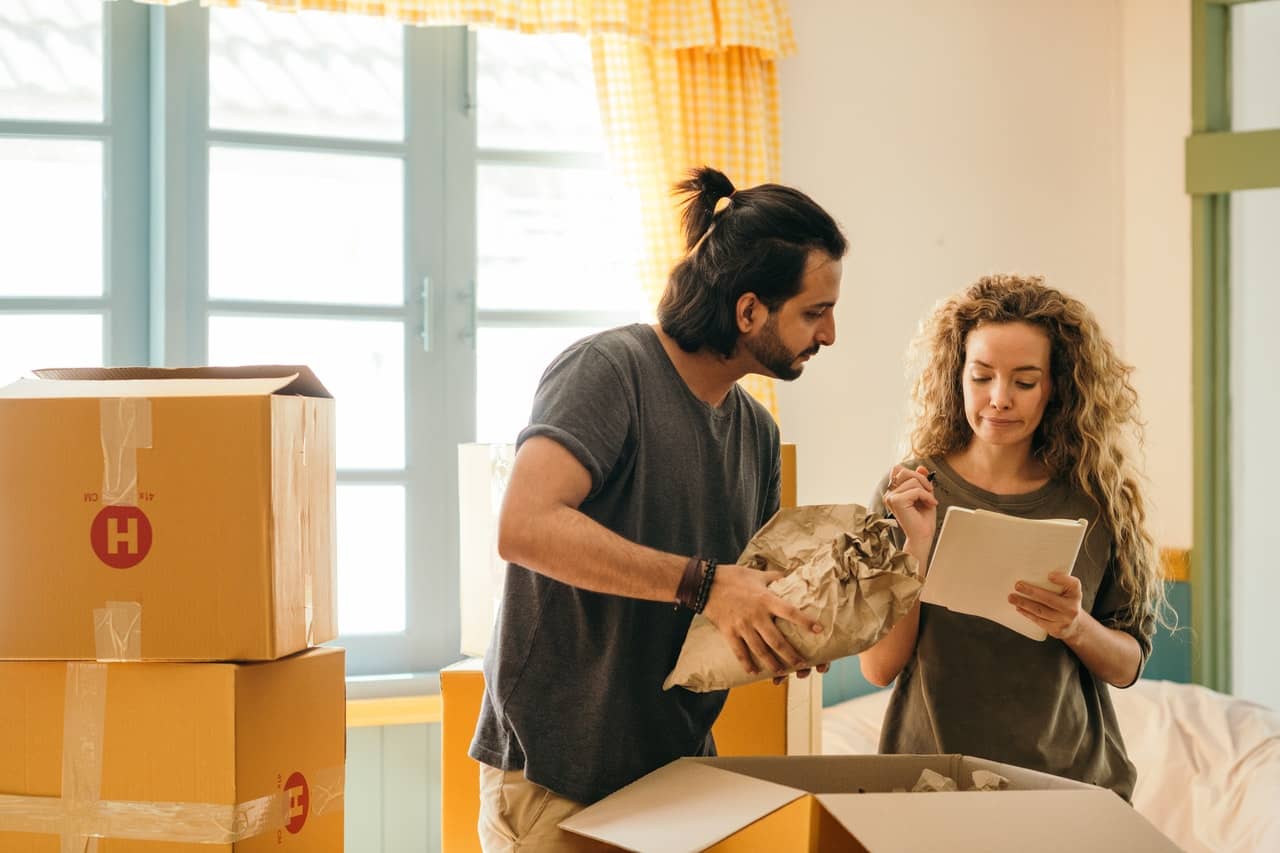If you’re frequently on the move, you know how hard it is to pack and unpack your things. This is especially true if you don’t stay in one place for more than a year. But when done right, you can make your move much easier, and even exciting.
You can then enjoy the landscapes you’d pass by while moving, and not dread how tiring moving is. With that said, here are some tried-and-tested moving tips you may want to consider:

1. Create A Moving Checklist And Budget
As mentioned, moving from one place to another can be an overwhelming process. These are the times when you find yourself looking up professional movers online. Moving not only involves a lot of steps and procedures, but it also can drain your savings if you’re not careful. On average, renters will spend thousands of dollars to move from one apartment to another. Not to mention the rent you’ll have to pay.
You can address this problem by being proactive and looking at every detail involved in the move. A great way to be proactive when moving is to set up a budget that’ll list down all your expected expenses.
To do this, you must first take inventory of what you’ll be bringing to your new home. Of course, you’ll include everyday items like clothes, kitchenware, and other essentials on your list. But a tip is to visit each room, then check and list down the items you’ll be bringing from each space. This way, you can avoid forgetting anything and bringing non-essential items.
Once you’ve figured out what you’ll be taking to your new home, it’s time to draft your budget. Making a budget is much easier now as there are many templates online that you can use as your inspiration. Regardless, there are basic moving costs you have to include in your budget, and here are some of them:
- Professional Movers: Hiring professional movers can save you more time and money than doing the moving by yourself. This is much truer if you’re moving long distances. If you’re using your own transport, you’ll have to pay for toll fees and fuel. But with professional movers, these are included. However, the cost of professional movers may vary depending on the total weight of your things, the distance of your old home from your new one, and the company’s rate.Different companies will have different rates, so make sure to check multiple ones. Some moving companies also charge differently depending on the time it takes to move. In such a case, you can save some money by being strategic with your moving plan.
One thing you can do is disassemble your furniture before the movers arrive. This way, they’ll spend less time packing. On top of this, packing service, insurance, and others may also affect how they charge. But in exchange, you won’t have to do all the carrying and moving on your own.
- After Moving-in Cost: Once you’ve transferred all your stuff to your new apartment, you might also encounter other expenses, which are known as after moving-in costs. For instance, if you don’t already have furniture, you may have to purchase such. Other expenses in this phase include utility setup and appliances. And not to mention small items like toilet paper and groceries.
- Packing Materials: Lastly, you also want to consider including packing material in your budget. Using old moving materials may not be the best option as their quality may have been compromised over time, especially if they’ve been stuck for more than a year. But if they’re still in good condition, reuse them. If not, you’ll need to buy boxes, packing tapes, labels, furniture covers, dishware boxes, and other packing materials.Since you’ll be moving again, it’s best to preserve their quality so you could use them next time. Do so by placing them together in a space where they don’t get exposed to the elements. It’s also best to label them as your packing paraphernalia so you can find them immediately.
2. Declutter
After setting up your plan and budget, it’s time to declutter. Doing this before you start moving may seem like an unnecessary step, but you’ll thank yourself if you include this on your list of to-dos. There’s no point in moving items you will no longer use in your new home, and bringing them with you is one of the common mistakes when moving. Doing so will eat more time. It might cost more money if you hire a moving company. So, decluttering your items before you start packing is a very wise move.
One of the best and efficient ways to declutter is to tackle each section of your home one by one. For example, you can start in the kitchen, then the living room, and work your way from there. Here are some of the areas in your home that might have more clutter than you realize:
- Kitchen: You want to throw away kitchen items that are broken, mismatched, or the ones you don’t use. These include expired food, sauce packets, duplicate kitchen tools and utensils, plastic containers and lids, old cookbooks, and worn-out cookware.
- Linen Closet: The majority of people have a linen closet filled with linens they don’t use. And you might be one of these people. If you are, it’s time to start bringing some serenity into your life by getting rid of linens you no longer use. If you think it’s wasteful to throw away linens, then you can use them by wrapping them around your delicate furniture. However, if you’re moving frequently, it’s best not to buy furniture, but choose fully-furnished rentals. This way, you won’t be carrying much on your next move.
- Bedroom: The majority of people’s closets and dressers have become a dumping space for unused stuff. Before moving, it’s a good practice to go through your clothing and other personal care items you know you won’t be using in your new home.
3. Organize
Balancing multiple moving tasks at once is not easy. But with the right managing skills, you can accomplish it. And organizing is quite easy once you start to get the hang of it.
It certainly is challenging to go through dozens of boxes to look for kitchen utensils. A great trick to make things a little bit more organized is categorizing each box. This means things of similar sort should go to the same box.
Additionally, label each box according to its usage. For instance, if they came from the bedroom, then mark them as ‘bedroom stuff.’ In this way, unpacking your belongings when you’re in your new home will be a breeze since you already know where to place each box.
It’s also best not to put all your stuff in one area and start boxing them. You should go room by room so you won’t mix your things in one box when you start packing.
4. Pack Your Belongings The Right Way
Packing your belongings is definitely the most time-consuming part of moving. So, you should look for ways to take shortcuts as much as possible to save yourself time. But you don’t want to compromise your belongings for the sake of efficiency. Considering this, here are a few packing tips you can apply for a better and smoother move:
- Designate a specific color for your boxes. For example, you can put all kitchen items in a pink box, and then green boxes are for bathroom stuff, and so on. Or at least put a sticker with a specific color for different box categories. This will save you so much time in figuring out which box goes where.
- Use sealable containers to store small items and other knick-knacks. This way, you won’t have to waste more boxes on small items such as spices and gadgets.
- Before disassembling your TV, take a picture of its back. Remembering where each wire goes can be pretty challenging. Having a reference for setting it up later on will make things easier.
- Keep the clothes on hangers. There’s no need to remove clothes from the hangers. What you can do instead is to group the hangers and clothes by category and put them in clean plastic bags.
- Prevent spillage by wrapping plastic around liquids that might spill. Secure the lids of containers for shampoo, soap, cleaning supplies, and other items to prevent further mess.
- Utilize linens, towels, and other clothes by wrapping them on fragile and breakable items. You can do this for glass bottles, plates, lamps, and vases. If you have more expensive items such as perfumes, then you can wrap those with linen. Lastly, secure your knives and other sharp objects by wrapping kitchen towels around them.
- Use your suitcases. Instead of taking out more boxes, you can place some of your items inside your luggage. Transferring stuff using your suitcases is much easier as the wheels allow them to be rolled. This is especially useful for heavy items like books.
- There’s no need to empty your drawers. You can take the drawers out and leave each item inside. This way, you wouldn’t need to put each item back in its designated drawer. You can secure each drawer by putting a plastic wrap on top. Another option for you is to carry the entire drawer as it is if it’s not too heavy.
- Photograph each box before you close it up. A quick snapshot of what’s inside the boxes will allow you to avoid rummaging throughout each container to know what’s inside.
5. Set Up Kid And Pet Arrangements
It’s also best to have your children or pets stay with a close friend or family member during the day. Having little children or pets run around while you or the movers are moving boxes can be dangerous. It might expose your child or your pet to potential injuries. Apart from this, children might take away your time and attention that you could otherwise spend moving your stuff away.
If you don’t have someone who can babysit your child, then be sure to keep them away from the hustle and bustle. For instance, let them stay and keep them occupied in the yard until all boxes are placed in the moving truck.
6. Be Ready On The Day
Aside from keeping your children and pets away from the house, it is best to prepare yourself and other things on the ‘day.’ Here are some tips about this:
- Have A Good Sleep: It’s essential to sleep well the night before the moving day. This way, you can wake up early and be ready when the movers arrive. If not, you could end up not having breakfast. But by waking up early, you can have a good meal before it gets busy. And you can do your last-minute packing on the stuff you’ve used the night before the ‘day’.
- Dress Appropriately: More importantly, you might consider dressing right. If it’s winter, wearing enough clothing to keep you warm is essential, although you can stay inside and let the movers work. There are instances when you need to check how things are going, so it’s best to be prepared. What matters most is that your clothes can protect you against extreme weather conditions.
- Check Your Electronics: This means ensuring all your phones, power banks, and other gadgets are fully charged. In this way, you can contact anyone throughout the moving process. You don’t like to have a dead phone before you arrive at your destination. And in case you encounter some incidents, you can easily call someone for help.
Conclusion
Frequently moving to a new place can be exciting, but the process of moving your stuff from one place to another can be exhausting. And if you do it often, you’ll be stuck with the dilemma of going over the packing and unpacking routine. Thus, it’s best to consider the tips above to ensure you’ll have a smooth move each time you do it.
From organizing to seeking help from professional movers, you can save much time. And as a result, you won’t be so exhausted that you’ll miss the exciting part of moving to another place: watching the landscapes during the travel.















